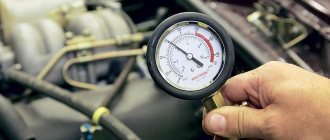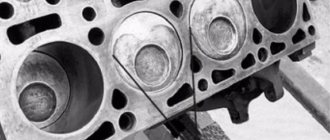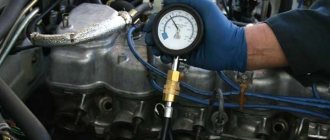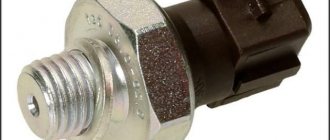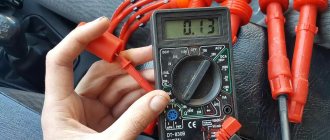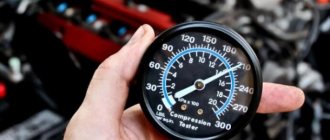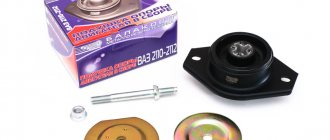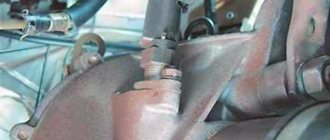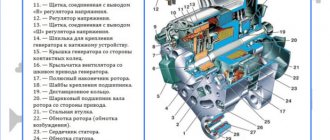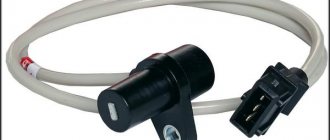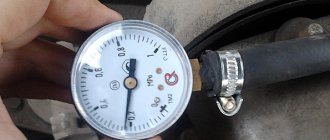Procedure for checking compression
1. Disconnect the connectors of the fuel cutoff valves of the high pressure pump.
2. Turn off the high pressure pump doser.
3. Remove one of the glow plugs.
4. Connect a compression gauge or compressograph to the glow plug flange.
5. Perform a compression test with the starter on. The measurement is considered complete when the compression gauge readings stop increasing.
6. Repeat the measurement, installing the device in place of the next candle. Record the results of each test.
7. Reinstall the spark plugs.
8. Connect the connectors of the fuel shutoff valves and turn on the high pressure pump metering unit.
Theory
In order to avoid such errors, it is worth getting acquainted with the theory. In addition to compression in the cylinders, there is also another value called the compression ratio. The compression ratio is just a geometric value that reflects the relationship of the combustion chamber between the head and the piston at its positions at top and bottom dead center.
Usually this value is stable and cannot change during normal operation of the engine. It can be changed by boring the engine or, conversely, installing a thicker gasket. It is worth noting that this value is greater than that of gasoline engines.
So it turns out that most often these two concepts are confused, although compression is a physical quantity, measured in kilograms per square centimeter, pci or bars and, in fact, is the pressure that is created in the engine cylinders when the piston operates. The compression amount is always greater than the compression ratio.
This arises accordingly as a result of the action of physics. As the piston passes through the cylinder, friction occurs, which results in heating. And it turns out that this same energy is given not to the metal, but to the air that is in the cylinder. The air increases in volume, the pressure increases, so the compression ratio will always be less than the compression on a diesel engine, and on a gasoline engine too.
Check conditions
The nominal compression value and the maximum tolerance value can be found in the operating documentation for the vehicle.
The compression check should be carried out at a crankshaft speed of 200-250 rpm. Also a necessary condition for the accuracy of the measured readings is the condition of the air filters. If the filter is clogged, the compression readings may be distorted.
Compression measurements are carried out in the temperature conditions in which the actual engine start usually occurs. There is a direct relationship between ambient temperature and the minimum compression at which the engine can start. This characteristic for a specific engine can be obtained as a result of a series of tests carried out in a service station.
Measuring engine compression is the simplest and most commonly used way to assess the condition and wear of the engine (assessing the condition of the rings, liner wear and valve tightness). A compression test (measuring the compression pressure in a cylinder) is needed to find out the “real” compression in the engine cylinders and compare it with the nominal ones. and also to detect a “sick” cylinder. Thus, measuring compression allows you to identify a malfunction in the cylinder, then diagnostics are continued using specialized diagnostic equipment.
To measure engine compression, a diagnostic device is used - a compression meter . There are even more expensive devices - compressors. This is the same compression meter, only with the ability to graphically record parameters for measuring compression by cylinder.
On many gasoline cars, you can measure the compression yourself, if you want to unscrew the spark plugs, the main thing here is to ensure easy access to the spark plugs. For this purpose, it is enough to buy a simple compression tester for 500-800 rubles (it is usually enough for 2-3 engine diagnostics).
Advice: choose a device with a threaded tip, i.e. so that it is screwed into the spark plug hole, and not pressed into it. Then the compression measurements will be more accurate and can be carried out alone. Also check that the compression gauge pressure release valve is located in the head, which is screwed into the spark plug hole, and not under the pressure gauge. This way you will avoid underestimating compression values when measuring.
For owners of diesel cars, it is better to contact a car service center, because... dismantling an injector or glow plug requires special skills and a special tool, and you will also need a compression gauge with a special adapter for attaching it to the injector or spark plug hole. Although the TU-15A diesel compression tester is purchased from us specifically for a personal car, it is convenient for diagnosing it through the holes for the glow plugs.
Compression measuring device
Of course, to perform these measurements there will be a necessary tool, in this case it is a simple device that mainly consists of a barometer.
A similar barometer is also used in compressors, for inflating tire pressure, or in individual devices called the same name, barometers. But one caveat should be made: the compression gauge is designed for higher pressure.
A compression gauge is a simple design that basically consists of a pressure gauge. It, in turn, is connected to an adapter, which has the same thread bored as on a standard spark plug and has a similar appearance.
It was also said above that there is another device called a compressograph. The differences, as mentioned, are minimal, but the price advantage still remains with the first option. Although convenience can offset material costs.
Also, the price depends on many other factors that are also worth paying attention to. And the first and probably the most important factor is quality. Yes, even the cheapest product can be of high quality, but it is better to take something in the middle price category. And preferably from a trusted brand manufacturer.
How to check engine compression
Measure compression by observing the following rules: - the engine must be “warm” (60-80 degrees for the oil to have “working” fluidity); — the fuel supply should be turned off. You can, for example, turn off the fuel pump, injectors, or use other methods to prevent large amounts of fuel from entering the cylinders (so that the oil wedge does not erode); - You need to turn out all the spark plugs. Selective removal of spark plugs is unacceptable, as it increases the resistance to rotation and arbitrarily reduces the speed when the engine is cranked by the starter; — the battery must be fully charged and the starter must be in good working order. Sometimes compression measurement is carried out using a charging device. This increases the accuracy of parameter measurement, because Compression measurements in all cylinders occur at the same crankshaft speed.
HOW TO MEASURE COMPRESSION
Compression measurements are carried out both with the throttle valve open and closed (without touching or fully squeezing the gas pedal). Moreover, each method gives its own results and allows you to identify its own defects.
How often to measure the compression ratio
Vehicle manufacturers do not provide accurate data on the timing of checking the compression ratio. There are symptoms that indicate the urgency of such testing:
- One or more cylinders are not functioning properly, which leads to engine vibration.
- Oil consumption has increased significantly.
- Engine power has decreased.
- Blue or whitish smoke comes out of the exhaust.
- Problems starting when cold.
You can measure the pressure in the cylinders together when replacing spark plugs every 20-50 thousand km. mileage This way you will protect yourself from possible problems with the engine in advance.
It may be interesting: What is the best way to inflate a tire?
When to check measurement parameters
The compression test procedure must follow the correct scenario. It is necessary to clearly know the diagnosis in order to correctly determine the condition of the machine. For example, if a car doesn’t start well in winter, it means that the compression needs to be measured when starting on a cold engine. Each engine has its own documentation, which indicates the compression ratio, as well as compression - the minimum parameter, optimal and maximum permissible.
If the compression does not match these parameters, the car will start and perform much worse. The normal compression level in a modern diesel engine is 20-25 bar. For an old diesel car the figure is 28-32 bar. The new Common Rail system reaches at least 15 bar for optimal performance. Poor compression on a diesel engine can indicate many problems with the car.
Let's consider the main elements that are important for the compression of a diesel engine.
examination
CPG.
The compression performance of a car engine largely depends on the serviceability of the cylinder-piston group. The state of the CPG is the most important factor in determining the desired parameter. In this case, everything depends on the tightness of the engine. The better the condition of the car's engine, the less loss of air flow through joints and components. Of course, factory assembly is accompanied by fairly strict and vigilant control. When leaving the factory, the car has minimal air flow loss, but during the vehicle's operation this figure may increase. If you take two cars of the same brand, with the same mileage, the indicators will still differ. This is explained by some factors influencing the condition of the cylinder-piston group:
- Amount of load. Thus, the state of the CPG is influenced by the intensity of acceleration, average speed and driving style of the motorist.
- The quality of the working fluid used. As a rule, the use of low-quality motor oil accelerates the wear of working engine components, while a good mixture prevents aging of the CPG.
- Vehicle operating conditions. With constant startup and operation in extreme weather conditions, the CPG loses its seal due to sudden temperature changes.
There is a fairly wide list of factors that positively or negatively affect the state of the CP. The reasons being considered are very obvious and understandable to every car enthusiast. In addition, there is a factor that is known only to experienced car enthusiasts or automotive repair professionals - the dimensions of the CPG.
diesel check
Professionals have traced the proportionality of the increase in maximum mileage to the direct increase in engine dimensions. One of the characteristics that influences the engine's operating time is the size of the cylinders. Thus, we can say that the larger the engine, the longer it lasts, and the compression drops much less. Despite the fact that with large dimensions of the engine the amount of air passed through increases, when converted to a liter of volume the loss rate will be much lower than for a small engine.
This can easily be explained by the fact that even with slight wear of the CPG in small cars, compression drops sharply. As a rule, the compression of a serviceable motor is in optimal condition due to the appropriate level of rings. During operation, the rings begin to lose their roundness and allow air flow to pass through, causing the engine to lose compression. With equal mileage, the rings of large engines retain their structure longer due to their massiveness and, accordingly, maintain the required gas pressure.
Thus, we can conclude that its reliability largely depends on the massiveness of the engine and the compression level will decrease much more slowly than on an engine with small dimensions. If we consider diesel engines, then this rule becomes even more relevant, since compression plays a decisive role in the proper operation of a diesel engine.
Compression test procedure and tools
Measuring compression on a diesel engine is not much different from a similar measurement on a gasoline system. In particular, compression testing is most often carried out through the glow plug paths. True, the verification procedure is a little more expensive due to the fact that when dismantling the glow plug, it may break off. What compression meters are on the market?
Compression gauges for glow plugs. The most optimal option, data accuracy and tightness.
There are also compression gauges for checking through the injector connector
Cold engine measurements
This option is suitable if launching is problematic. Compression in the cylinders of a cooled engine can be half the standard values due to severe wear of the cylinders and pistons (6-7 kg/sq. cm). However, after some time from the moment of starting and warming up the engine well, the pressure will increase by 3-5 divisions.
If such growth is not observed, we can clearly conclude that your car needs major engine repair work. Therefore, for a more accurate measurement, carry out two options for testing the pressure: on a warm and cooled engine.

